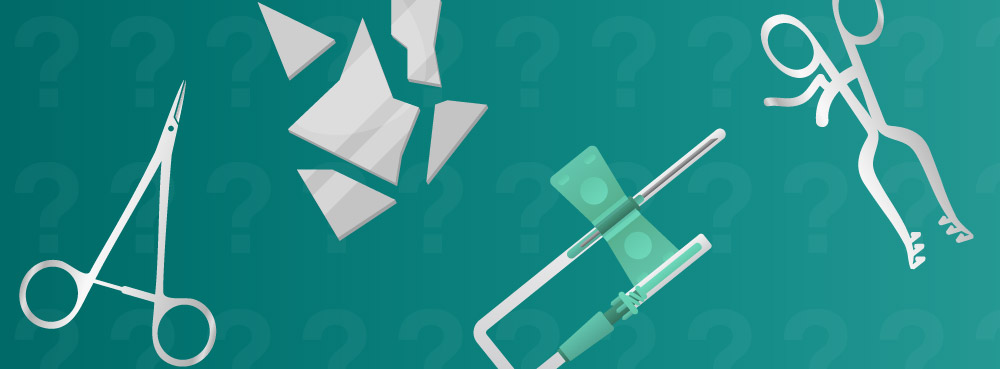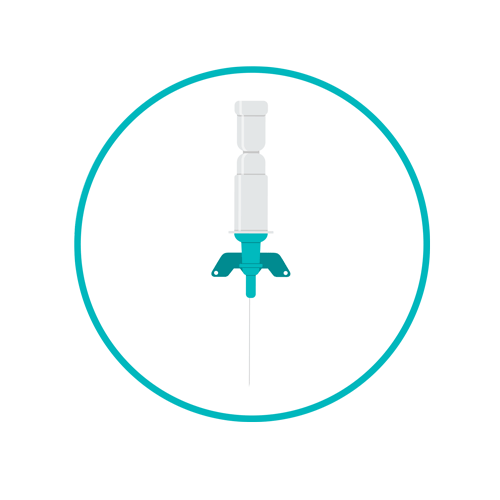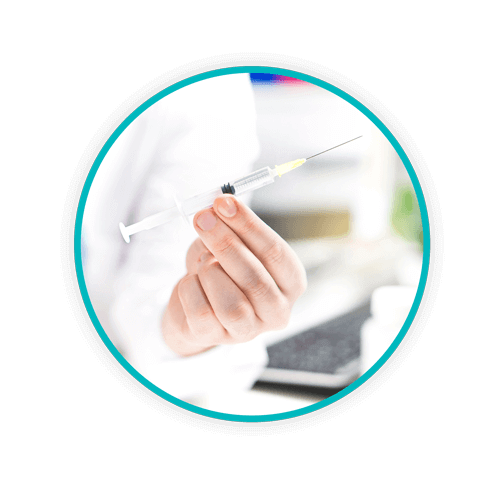What Are Sharps? Everything You Need to Know

When asking what sharps are in a healthcare environment, some people may only identify an image of a needle and the red containers that used needles and syringes go into. However, health care professionals know that a “sharp” is broadly defined as anything that has a sharp edge to it. Such objects are even more dangerous if they come into contact with biohazardous waste (e.g. blood, an infectious bodily fluid), or if they are handled by the unsuspecting public.
TOPICS WE WILL COVER:
2 / When does a sharp become medical waste?
4 / Finding guidelines for sharps disposal processes
5 / Use Compliant Sharps Containers
6 / Daniels Health Focus on Safety
What Are Sharps?
Sharps Definition (Medical)
For those wondering what sharps are, they are items used in healthcare settings that possess points or edges sharp enough to pierce or cut human skin. According to the Occupational Safety And Health Administration (OSHA), they pose a risk of injury or the spread of communicable diseases if not handled correctly.
What Goes Into a Sharps Container?
In addition to needles, objects that are defined as “sharps” and would therefore go into a sharps container, include:
- Trocars
- Empty or broken ampoules
- Broken, rigid plastic
- Butterflies
- Suture needles
- Culture slides and dishes
- Broken glass
What Is a Sharps Container?
A sharps container is a specialized, puncture-resistant waste container specifically designed for the safe disposal of sharps. It is typically made of rigid plastic and is used to prevent needlestick injuries and ensure safe containment and disposal of items such as needles, scalpels, and other sharp medical instruments.
Individuals working in an environment outside of healthcare facilities where needles, tools, or equipment can be found, should be aware of the rules and regulatory requirements regarding their handling and disposal. That includes cosmetic surgical centers, tattoo parlors, body piercing businesses, and funeral homes.
This is even more important when any sharp object has come into contact with potentially contaminated or infected blood, body fluids, or a substance that can carry bacterial or viral dangers to the general public. Such items are deemed dangerous and would be defined as infectious/biohazardous waste.
When Does a Sharp Become Medical Waste?
This refers to any object with the potential to pierce, poke, impale, scrape, or cut the skin and has possibly been contaminated with bodily fluids, per OSHA. Many dangers are associated with improper sharps disposal, and needlestick injuries are listed among the most prevalent.
What Happens To Medical Sharps Waste?
Who Picks Up Sharps Containers?
Companies like Daniels Health specialize in the collection, transportation, and destruction of sharps. Our operations are assisted by a dedicated compliance team that oversees adherence to all state and federal regulations related to the management of sharps waste. Speak to the friendly team to organize your next pick up.
Risks Associated with Improper Sharps Disposal
Dangers associated with improper sharps disposal are severe. It is vital that all healthcare providers who utilize sharps in the course of their procedures or business practices know how to identify sharps and determine whether they might be contaminated.
For example, needlestick injuries can result in HIV infection or exposure to Hepatitis B (HBV) and Hepatitis C (HCV) infections.
The CDC’s Role in Needlestick Injury Prevention
In November 2020, the Centers for Disease Control and Prevention (CDC) celebrated the 20th anniversary of the Needlestick Safety and Prevention Act. A number of new requirements have been added over the years to provide protection to healthcare workers and the public.
Some technological advancements include the use of engineering controls in regard to needle-free systems, enhanced OSHA recordkeeping requirements, sharps injury laws, and employee comments and feedback on use of safer medical devices and other technologies that reduce exposure to needlestick injuries.
According to data provided by the CDC in 2018 and 2019, devices most commonly involved in a sharps injury continue to be disposable hypodermic syringes and suture needles.
Safer and newer technologies are currently being explored to aid in the reduction of further injury. Increasingly common sharps injury prevention features such as retracting or shielded needles and blades have been devised, but despite widespread availability, they are not used in many instances.
The primary objectives of sharps safety protocols are to prevent needlestick injuries and ensure the proper disposal of sharps waste.
Safe Handling and Disposal of Sharps Waste: What to do with Sharps Containers
Governmental agencies such as the EPA and OSHA provide specific public health standards for proper segregation and use of sharps containers and storage, as well as disposal recommendations for sharps waste.
Who should empty a designated sharps container?
The task of emptying a designated sharps container should be carried out by trained personnel who are well-versed in proper sharps container usage and placement. They should also know and understand OSHA regulations as well as state-by-state guidelines for not only placement of sharps containers in a variety of scenarios, but processes involved in sharps container removal prior to disposal.
When should sharps containers be emptied?
Sharps containers should be emptied before they reach full capacity, which is typically when they are about three-quarters full. This precaution helps to reduce the risk of needlestick injuries to personnel handling the containers. A sharps container should have a clear line that indicates when it is ready to be emptied.
How to dispose of sharps containers
- Disposal of sharps containers must be done with care. Prior to disposal, sharps containers must be sealed. This reduces the risk of a needlestick injury by personnel removing the sharps container. This also keeps handlers safe during transportation and disposal processes that are approved on a state-by-state basis.
- Every sharps container must be properly labeled and identified based not only on federal guidelines provided by the EPA, but by the state and sometimes even local municipalities.
Where to dispose of sharps containers
Sharps containers can be disposed of in several ways, such as:
Drop Box or Supervised Collection Points
Filled sharps containers can be taken to collection sites including hospitals, clinics, pharmacies, health departments, community organizations, and medical waste facilities. This is typically only viable for at-home sharps generators.
Household Hazardous Waste Collection Sites
Check with local waste providers for sharps collection sites. Used needles should be placed in FDA-cleared sharps containers and deposited at these sites.
Onsite Collection
Daniels Health is a leader in sharps management and waste disposal, trusted by health care providers and beyond.
Contact Daniels Health today to learn more about our comprehensive sharps management solutions.
Government Guidelines for Sharps Disposal
Federal regulations are clear in regard to healthcare waste management and medical waste disposal processes for sharps. Individual states also have unique guidelines that build upon federal regulations. Some state regulations are even more stringent than those provided by the federal government. Proper handling and disposal is essential to maintain compliance and to protect healthcare providers, the general public, and the environment.
Ensuring Compliance with Sharps Containers
Sharps compliance refers to the proper disposal of used sharps in a sharps container according to federal, state, and local community guidelines.
Finding Resources for Sharps Waste Compliance
Numerous governmental agencies and publications are readily available for access to information and guidelines in regard to sharps waste safety, handling, storage, transportation and disposal. Such agencies and publications include (but are not limited to):
- OSHA specifies bloodborne pathogen standards (via 29 CFR 1910.1030). Every state also provides guidelines that must follow OSHA standards. Many state guidelines exceed those provided by OSHA.
- The Federal Needlestick Safety and Prevention Act offers pertinent guidelines and processes in an effort to reduce occupational exposure to needlestick injury and provides information regarding compliant measures, procedures, and documentation standards for healthcare environments to prevent sharps injury.
- State-specific provisions in regard to legislation of needle safety can be found on the website of the CDC and the National Institute for Occupational Safety and Health (NIOSH).
Compliant Sharps Containers: A Critical Element
Guidelines for regulated medical waste provide instructions regarding compliant sharps containers. This information can be found in 49 CFR §173.197 – Regulated Medical Waste. The wording is clear: “Sharps transported in a large packaging, cart, or BOP [bulk outer packaging] must be packaged in a puncture-resistant, non-bulk inner packaging (sharps container). Each sharps container must be securely closed to prevent leaks or punctures in conformance with instructions provided by the packaging manufacturer.”
Note: Special guidelines and waste disposal protocols apply for containers exceeding 20 gallons (76 L) in volume.
The US FDA provides a clear definition of a compliant sharps container, which states that it must be made from “rigid plastic and come marked with a line that indicates when the container should be considered full, which means it’s time to dispose of the container.”
Guidelines are also provided for private, home-generated sharps waste disposal. In such cases, sharps containers must be constructed of heavy-duty plastic, have a tight-fitting lid, be stable, stand upright during their use, be disposed of when they are approximately three-quarters full, and adhere to community guidelines for compliant disposal methods.
Daniels Health Is Committed to Sharps Safety
Daniels Health is dedicated to reducing the potential of sharps or needlestick injuries. We design compliant sharps containers and recommend furthering safety by placing compliant sharps containers in patient rooms, surgical suites, and throughout healthcare facilities to further reduce risks of sharps injury.
For more information on what sharps are, as well as Daniels Health products, services, and guidance, call us today.
Let's Talk!
Your time is valuable, and we don’t want to play hard to get. You can either phone us directly on the details listed on our contact page, or feel free to fill out this short form and one of our team members will get back to you as quickly as possible.
